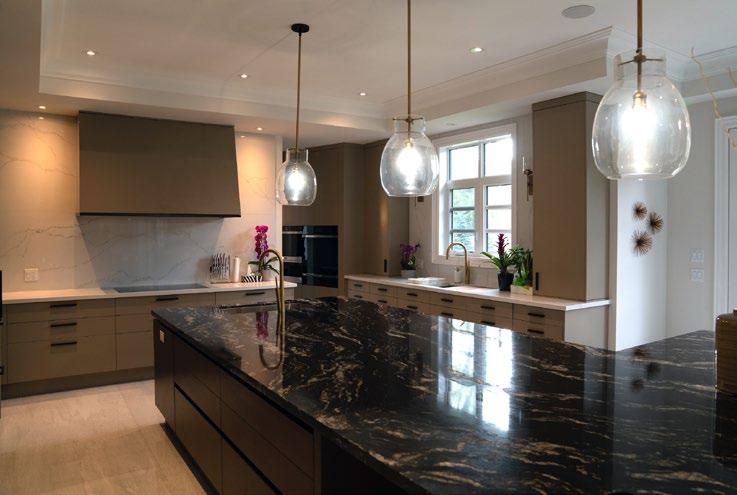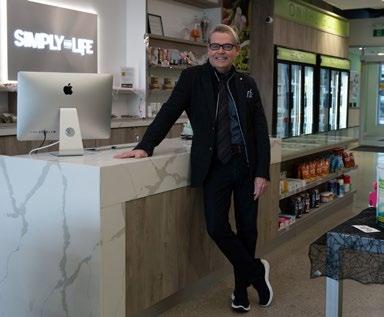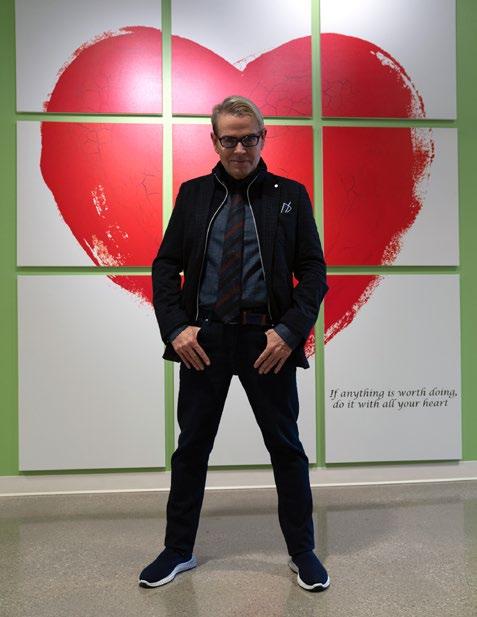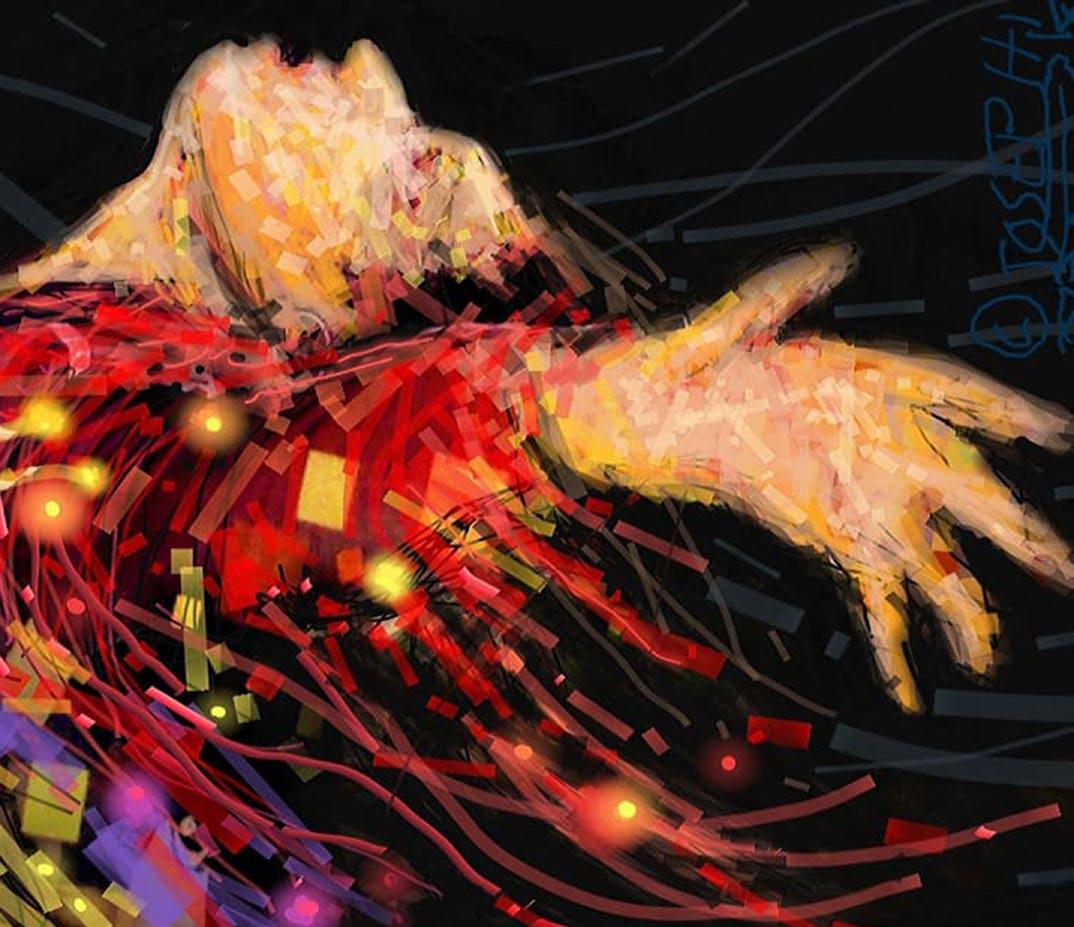
8 minute read
GLENN DIXON
Spencer Feature Interview GLENN DIXON
Meet one of Canada's most likeable Interior Designers
Advertisement
By Joseph Edward Schur
Many of you will know Glenn Dixon from Kimberly Carroll's hit television series 'Take This House and Sell It' on the W Network from 2004 to 2010. But there is much more to his story.
Charming and witty, it's no wonder that he's gained success as a television personality. Glenn is a brand expert, strategist and a highly respected Interior Designer specializing in retail, commercial and residential design.
He's also co-developed an internationally successful fashion company from the ground up, along with his brother, the iconic fashion designer, David Dixon. See page 51 of this issue for David's feature interview. I met with Glenn at one of his recently completed interior design projects in a luxurious mansion in Oakville. Seeing first-hand his design aesthetic gave me a real insight to just how incredibly talented he is.
Curious to learn how he tackles the challenge of retail design, Glenn suggested that we drop by another of his projects, 'Simply for Life,' a wonderful store promoting real food, nutrition and a healthy lifestyle. It proved to me that through excellent design practices, you can establish a relationship between the consumer and the retailer. The store was warm and inviting.
Joseph Edward Schur: Glenn, what are some of your earliest influences that drew you to interior design? That's wonderful! What are the big lessons that you have learned during your career?
Glenn Dixon: I would have to say my earliest influence would be my mother, when I was just a kid, my mother and I would often rearrange furniture while everyone was out of the house and wait for the surprise when the family came home to see the "new improved" layouts! This was fun for me.
I understand that your design aesthetic includes being inspired by nature.
One of my major influences is nature itself. Every space I've ever designed has one common denominator - Nature. Be it water, flowers, clouds, branches of trees and birds that fly. They all inspire me. Have you ever noticed that nature never gets colour or composition wrong? It comes so natural and beautiful.
What would you consider as one of your most career-defining moments?
The biggest lessons I've learned during my career is to never doubt yourself or your creative vision. There are so many people that cast doubt your way, don't listen and keep the people closest to you that support you and only want the best for you.
“Good Of all the projects you have worked on,
both big and small, which of those would
interior you say have changed and impacted your perceptions as an interior designer? design must In the beginning of my career, I thought act as vessel, that designing a beautiful space was what Interior Design was, I was wrong. Good interior design must act as vessel, conconduit or duit or translator for people. The goal with design is to bring out the best in all translator of us, whether it's a home and a reflection of the people living in it, or a store, where for people.” you want the customer to understand your brand and feel great being there. All design has to be focused on the human experience. It should always make us feel something.
One of the most career defining moments would have to be designing the Barbie home collection for Mattel. As a kid, my brother David and I would spend hours playing with Barbie and re imagining her life. I would build the perfect Barbie dream home out of cardboard boxes and popsicle sticks as hardwood floors. To have a full circle moment in life and design a real life home collection and naming it Barbie by Glenn Dixon was truly special. The universe always responds when we put dreams out there.
What is the design process you adopt at the start of a project that you hope has a profound and lasting impact? I mean, when you walk into a room, do you have an immediate design vision?
When I walk into any space, always my first reaction is "How do I feel in this space?" I always check in with me. One of the most important aspects to design is listening to your customer, who they really are and what do they want the space to say about themselves. It has very little to do with actual design. One of my super powers though is to immediately detect bad space planning and layouts, I can instantly tell what's wrong with the room.
As seen in the pictures here, your interior design of the Oakville, Ontario mansion, is nothing less than spectacular. How did you come up with your overall design concept?
My clients wanted a modern, yet approachable home that reflected their love of entertaining and family. They wanted a warm palette and putting it together was taking their favourite things about life and incorporating it into the house.
What room was your favourite place to design in this home?


How do you approach a commercial project versus a residential project?
Although the approach is very similar for me, ie: understanding the client’s goals and aspirations etc. Commercial design casts a wide net and has very distinct requirements, could be a restaurant, clothing store, bank etc. and each has it's own very different needs whereas a residential project generally has the same requirement, creating a home to love. Also in residential design, I'm solely focused on the client/s and family.
Like most homes, I love starting in the Kitchen, that is where the heart is and sets the tone for the rest of the house.
Did you work closely with the owners?
I consider the owners like friends as well in this case, we've worked together on several projects and we work together perfectly. In fact, many of my customers still are a big part of my life. There is something very intimate about working with people in their homes, you create a very large bond.
You also had another project debut recently, but it was commercial, in a retail setting. Can you tell us a little about your design there?
The healthy living store in Oakville - "Simply for life" was a dream come true for me, I spent months in development to make this store a place for all. I started with space planning and integrated Nature and it gives me great joy to know that everyone who walks in, has their breath taken away and feels immediately at ease. It was very important for me to build an immersive environment for people to not only want to shop there, but stick around as well.




In commercial design, it is imperative that you focus on the brand, the building and most importantly a wide range of customers so that they are satisfied.
What would you say is your biggest design pet peeve?
Poor lighting. It's really important to have various level lighting that is soft and also accomplishes several duties, be it task like in the kitchen or reading in the living room, I love a well lit room. Also as I get older, I like to take off a couple of years with the right amount of lighting! Dimmers are your friends.
What are your favourite home design tips that you can share with us?
- Start with a mood board, take clippings and colours and objects that inspire you. This will be your blueprint in designing your home - Don't buy a patterned sofa, stick to solids. While you may love a rose garden today, it will ultimately wither in time. Add texture and prints through things like throw cushions and accessories. - Keep neutral walls, rooms should flow from one to another. Make the rooms stand out through through artwork and your life's belongings; the walls should be the blank canvas. - Pay attention to lighting and make it feel wonderful during all times of the day. - At all cost, avoid vertical blinds!
If you hadn't become an interior designer, what would you have been?
A super model!
Truthfully, what I love most in life is the ability to communicate with people and make them smile. So perhaps a comedian or an actor.
You are a media personality and an interior designer. In your career, you have spent a lot of time in front of the cameras, whether on "Take This Home and Sell It" or co-hosting "Daytime Toronto." Any plans for returning to television?
I've just finished a project for a new television show that's debuting soon, only this time, it's behind the scenes. I still get that rush from the work and I love it immensely. As for "in front of the camera,” who knows what time will bring.
What do you see as the overall future of interior design over the next decade?
I believe that given the world's direction that the "disposable design" aka: poorly made, instant gratification pieces will no longer play a role. I think that what people will demand will be sustainable pieces that will look good today and in a hundred years. People will be buying quality.
What's currently keeping you excited as a designer?
The most exciting thing about my job is to make my clients happy; it's never changed.
Photo Credits: Jonathan Levy

Spencer Arts & Culture
with Joanne McLennan, ARTS EDITOR
Ann Shin's A.rtificial I.mmortality, Heidi von Palleske, Defining Moments by Stephen Wallis, Rosita Stone, Alyssa Rubino, NFT BAZL Miami Event, Eric McKinnon's Broken Cage Gallery: Featuring Todd Monk, Greg
Benz, Fanny Rice, Steep Daniels, Logan Ford and Sonny, Transform Exhibit: Painting The Way Forward Max Jamali's Feature Interview + "Life Is A Mystery" Show at the Vagabondo Restobar, Estelle Ohayon's The End of the "Art Oligarchy," Joseph Zambri's "Journey of an Artist" Series

Max Jamali's Canadian Indigenous Artist, "Life is a Mystery" Show Joseph Saga











